What are intake and exhaust ventilation systems
One of the conditions of our normal existence is fresh air. However, most residential premises cannot provide this, especially if they are equipped with double-glazed windows. Due to inadequate ventilation, humidity increases, condensation appears, and unpleasant odors are not removed. Below we will tell you how to prevent such troubles.
A simple but effective method is the installation of ventilation equipment. Its price can reach thousands of rubles, and maybe very cheap. It depends on the air exchange system used in the room.

Most of them are able to create and exercise control over favorable conditions, in particular:
- maintain a constant temperature;
- to keep relative humidity in the room at an optimum level;
- control the speed of the air flow;
- Do not allow excess concentrations of harmful impurities.

Types of ventilation
Today, several variants of air exchange systems have been developed that can provide a comfortable indoor environment.
They are classified according to the following criteria:
- how they move the air - natural or artificial;
- their purpose - supply or exhaust;
- for which zones are intended - general exchange or local;
- design - channelless or channel.
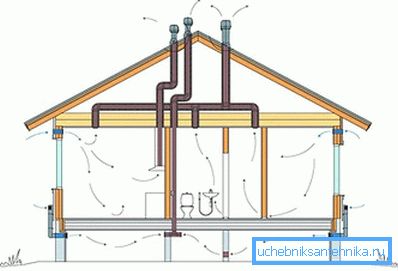
| Natural | In this case, the air masses move because of:
Such systems are simple and do not need complex equipment, as well as power consumption. You can easily make your own hands. But, their effectiveness often depends on variable factors, including the temperature of air masses, wind speed and its direction, so it makes no sense to consider them reliable. |
| Forced | These systems consist of fairly sophisticated equipment and control devices, the price of which can be quite high:
This makes it possible to move the incoming fresh air over long distances. The units are able to supply fresh air and remove the exhaust air in the required volumes, regardless of the environment. Only it is necessary to consider that in this case the cost of electricity for their work can be quite large. They are classified according to the method of supplying and removing air, so they can be:
The instruction requires when choosing to take into account the purpose, volume and specific features of the room (the presence and nature of the source of pollution, the number of people, the layout). |
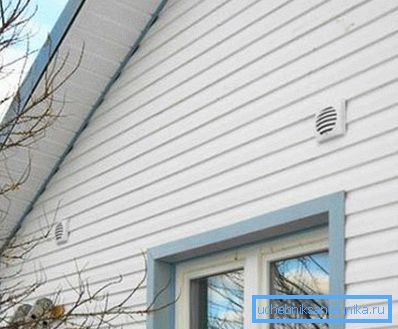
Supply ventilation systems
Their main purpose is to supply the required amount of air into the room.
Usually, before this, he passes a certain level of training, which may include:
- external dusting;
- heated during the cold period;
- cooling in hot weather;
- Moisturizing to maintain normal moisture balance.
The ventilation system can be placed in one case or recruited from individual elements, including, it includes:
- fans;
- filter;
- air heaters;
- coolers;
- valve;
- duct system;
- air flow distributors.
In one hour, the capacity of the installations can be tens (mini-inlets) or several tens of thousands (main inlets) of fresh air.
Tip: with the help of a heating element, you can provide in the winter time the heating of air to a temperature in the range of 18-29 ° C, and then bring it into the room.
The system has the following components:
- Air intake grille through which outside air enters the ventilation. In addition to the decorative function, it protects the system from foreign objects and precipitation in the form of rain and snow.
- An air vent valve is required to protect against the ingress of outside air into rooms with the ventilation system turned off.. Especially the device helps in the winter.
- The filter is a barrier to fluff, dust and insects. The system can be of two types - coarse and fine cleaning.
Tip: once a month the filter must be cleaned of accumulated dirt.
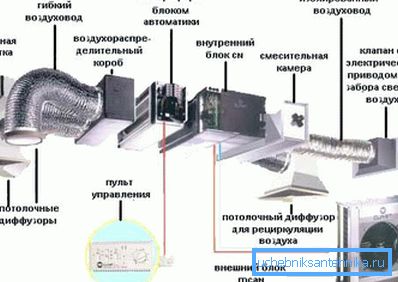
- The air heater heats the outdoor air masses coming from the street in winter. Use an electric or water circuit.
- Silencer protects residents from constant aerodynamic noise propagating through ducts during equipment operation.
- The fan delivers fresh air into the room and creates the necessary pressure of air masses..
- Air ducts are used to distribute air masses throughout the premises.. Apply tees, turns and adapters. They can be rectangular and round in cross section, as well as flexible or rigid. For their manufacture using metal or plastic.
- Air distributors are required for air flow into the room. This is usually a different type and form of grille or diffusers. In addition to the decorative functions, they evenly disperse the air flow through the room, are used for its individual adjustment.
- Automation - serves to regulate and control the ventilation system.
Control
For air exchange of apartments and houses are actively used small ventilation systems consisting of a network of air ducts with air handling unit. The control is carried out with the help of a remote control, which makes it possible to regulate the air supply and its heating. There are also devices equipped with timers that include installation at a specific time.
Often, it is possible to connect an external exhaust fan to the system. Thanks to the automation of the ventilation system, synchronous operation of the inlet and exhaust devices is ensured. After installation and connection, an act of acceptance of exhaust ventilation systems is drawn up, ensuring their proper operation.

Device overheating protection is usually provided by thermal protection built into the winding of the fan motor. The heater is equipped with thermostats that also protect against overheating and fire.
Acquisition of supply systems with a differential pressure gauge, used to monitor the dynamic pressure differential in the incoming air flow, is allowed. If the unit stops working, access to the cold air room is automatically closed.
Exhaust Ventilation Systems
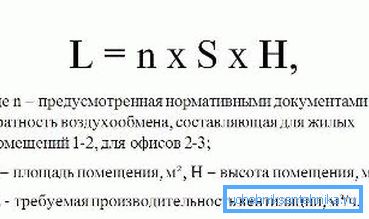
The main purpose is to remove polluted air from the apartment and house. Mechanical exhaust ventilation is usually simpler than the supply air and can have only one fan or even natural exhaust if the volume of the room is small. If it is required to remove exhaust air from several rooms or rooms of complex planning, installation of intake ducts is required.
Supply and exhaust ventilation systems
Let's find out what is the exhaust ventilation system. This is the most frequent and effective option, which provides and supply, and exhaust air from the room. In this case, the two systems operate simultaneously.
Their performance should be the same, then there will be no difference in air pressure outside and inside the building, which leads to the effect of “slamming doors”. Such systems can operate on the basis of ventilation systems or be in the form of individual parts.
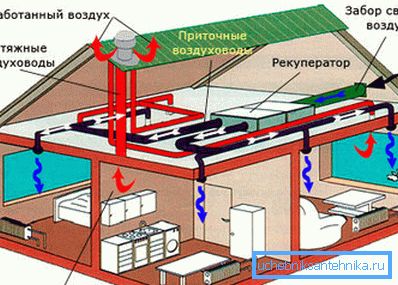
Conclusion
Compliance with the air exchange balance in the room is responsible for ventilation, which can be of a different type and depends on many factors. In this case, it was told about the main ones - natural and forced (supply, exhaust, and supply and exhaust).
If you follow the rules for using the systems, you will be able to ensure the correct supply of fresh air and timely discharge of waste. The video in this article will help you find additional information on this topic.